Learn how to make THE BEST simple, easy sourdough focaccia bread (step-by-step recipe!) with bubbly, active sourdough starter, an overnight rising option, and tips for par-baking the dough. So soft! So fluffy! Focaccia recipe adapted from my book: Artisan Sourdough Made Simple.
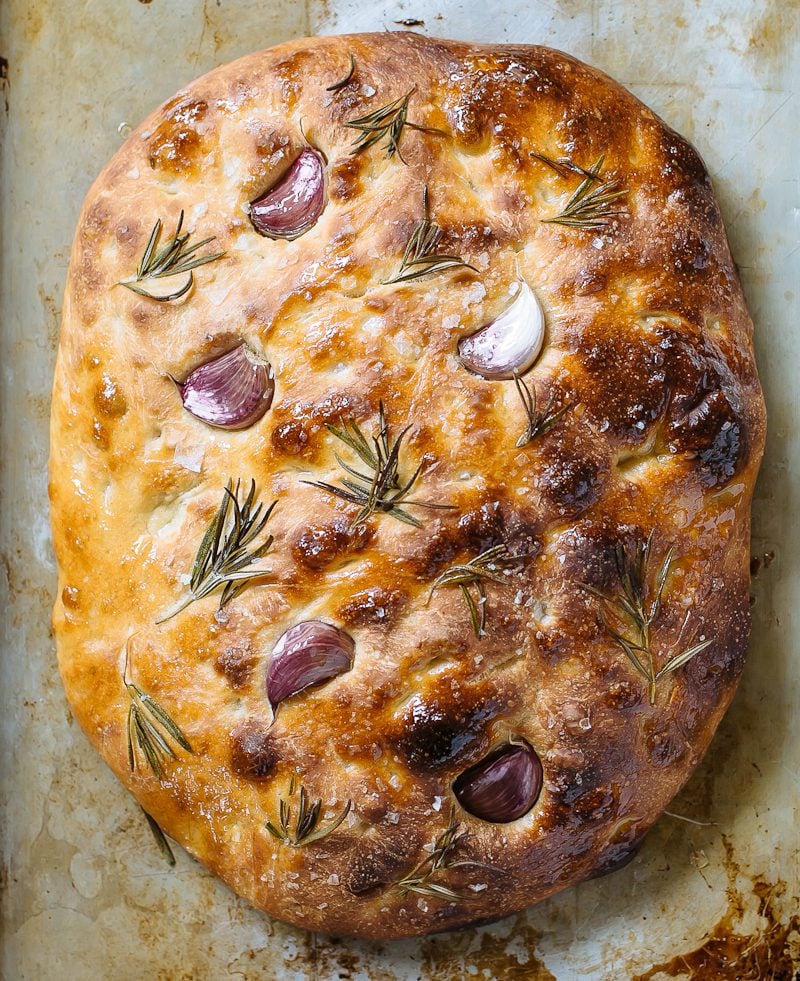
If you’re new to sourdough bread, or want to expand your collection of easy sourdough bread recipes, may I suggest your next move? My sourdough focaccia is crisp on the outside, soft in the middle and packed with sourdough flavor in every bite.
Adapted from my book Artisan Sourdough Made Simple, this easy sourdough focaccia recipe is perfect for both beginners and seasoned bakers alike. There’s no kneading, no bread scoring, no Dutch oven. Just a handful of ingredients, a bread pan (or not) and some hands-off time to let the dough rise. That’s it.
I make this sourdough focaccia recipe at least once a week to serve with fresh homemade pasta and various soups, like my creamy, 30-minute butternut squash soup. Leftovers make excellent homemade croutons and breadcrumbs. Or make your own sourdough pizza crust with basil pesto sauce and melted Fontina cheese. So many options! PS: poking soft, squishy bread dough is very therapeutic. Let me show you how to make it.
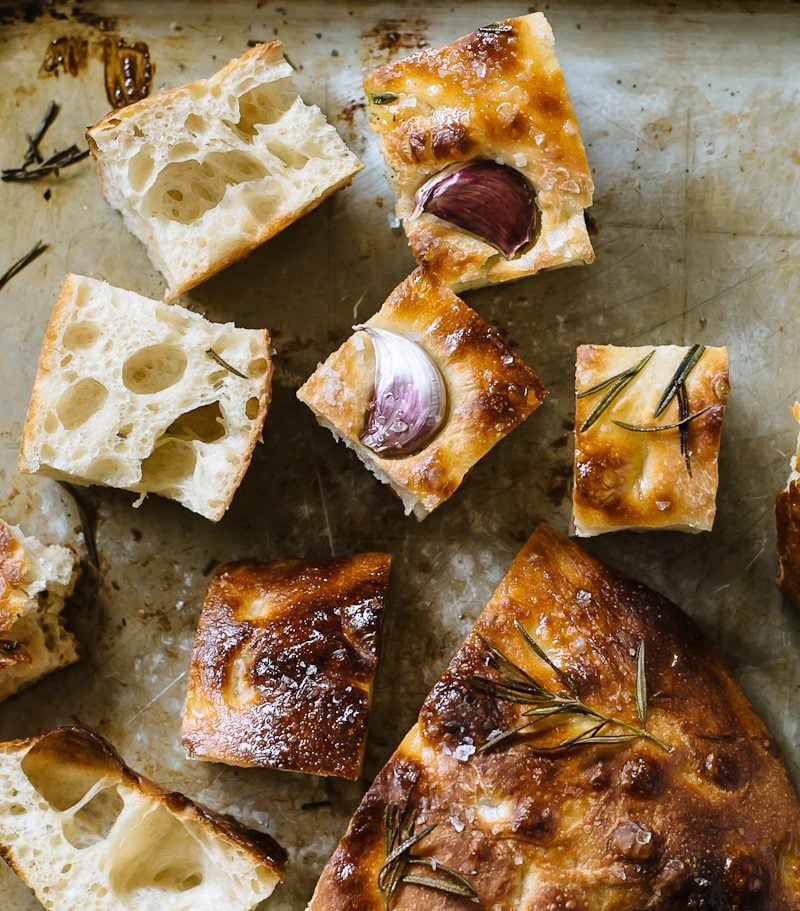
What is Focaccia? And Why Sourdough?
Focaccia (pronounced fo-kah-cha) is a classic Italian “flatbread.” Focaccia can be both sweet and savory, thin or thick, baked plain, or adorned with a variety of toppings- there are many styles to choose from.
While most focaccia bread recipes are made with instant yeast, sourdough focaccia is different. It uses a bubbly, active sourdough starter to naturally leaven the dough- instant yeast is not required. In addition to rising power, sourdough creates a slightly chewy texture and a unique depth of flavor. It’s a major selling point!
How to Get a Sourdough Starter
You cannot make sourdough bread, of any kind, without a sourdough starter. There are several ways to get one. You can make it from scratch (Beginner Sourdough Starter Recipe), buy it online, or ask a friend to share some with you. Even bakeries are selling their starters these days. Alternatively, if you already have a sourdough starter and would like a refresher course, read this post: Feeding Sourdough Starter: My Best tips and Tricks.
Beginner Sourdough Focaccia Tips
- Think ahead: Feed your sourdough starter a few days in advance, prior to making the focaccia dough. This will ensure a vibrant starter that’s strong enough to make the dough rise.
- Use regular olive oil (not extra virgin). It has a higher smoke point and is less likely to burn the top and bottom of your focaccia.
- Pick your pan. Sourdough focaccia can be baked on a regular rimmed sheet pan or rectangular metal pan (think: brownie pan). If using the latter option, I highly recommend this non-stick pan by Lloyds. I’ve been using it for years. It’s truly non-stick.
You Will Need: Ingredients & Equipment
- Sourdough starter
- Water
- Honey
- Flour (all purpose or bread flour)
- Fine sea salt
- Assorted toppings (optional): rosemary, garlic, tomatoes, olives etc.
- Sheet pan or non-stick baking pan
How to Make Sourdough Focaccia {Step-By-Step}
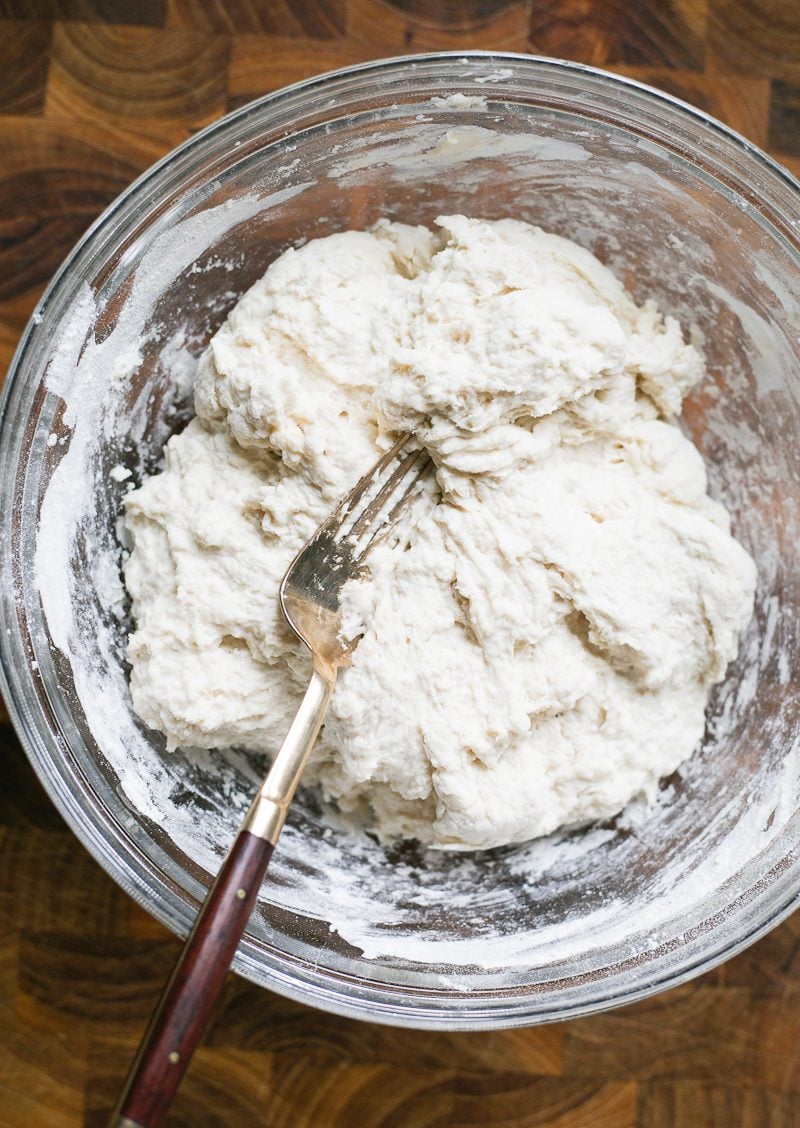
Make The Dough
- In the evening: whisk the sourdough starter, water and honey together in a large bowl (I use a fork for mixing). Add the flour and salt. Mix to combine and then finish by hand to form a rough dough. It will be wet and sticky.
- Cover and let rest for 30 minutes to 1 hour. Timing is flexible here. Then return to the bowl and work the dough into a ball. Again, the texture will be sticky and wet at this stage- all normal.
- When finished, transfer the dough to a lightly oiled, high-sided dough container or just keep it in the same mixing bowl. It’s up to you. The next step is to let the dough rise.
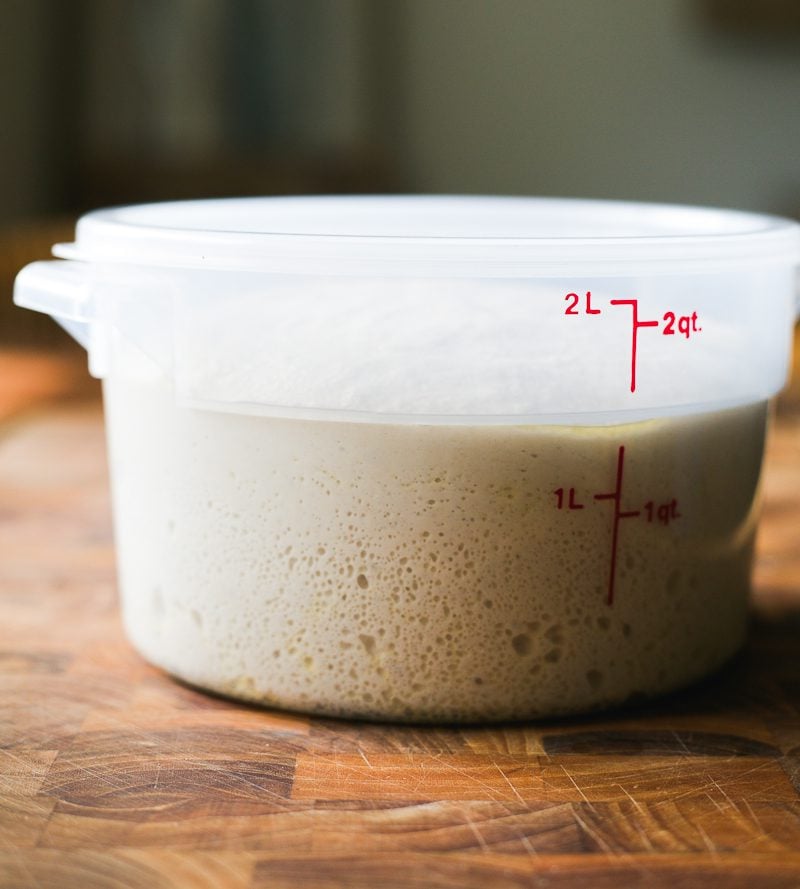
Bulk Rise
- Rest the dough at room temperature and let rise overnight on your countertop. The dough should at least double or triple in size when ready. This will take approximately 12+ hrs @ 68 F (20 C).
- Note: the warmer the temperature, the faster the dough will rise. So for example, if your current room temperature is 80 F (27 C), the 12+ rise time mentioned above would not apply to your specific environment. Not even close. The rise time would be shorter, say 3-4 hrs. Simply put: watch the dough and not the clock!
Diving Deeper: Why Won’t My Sourdough Bread Rise?
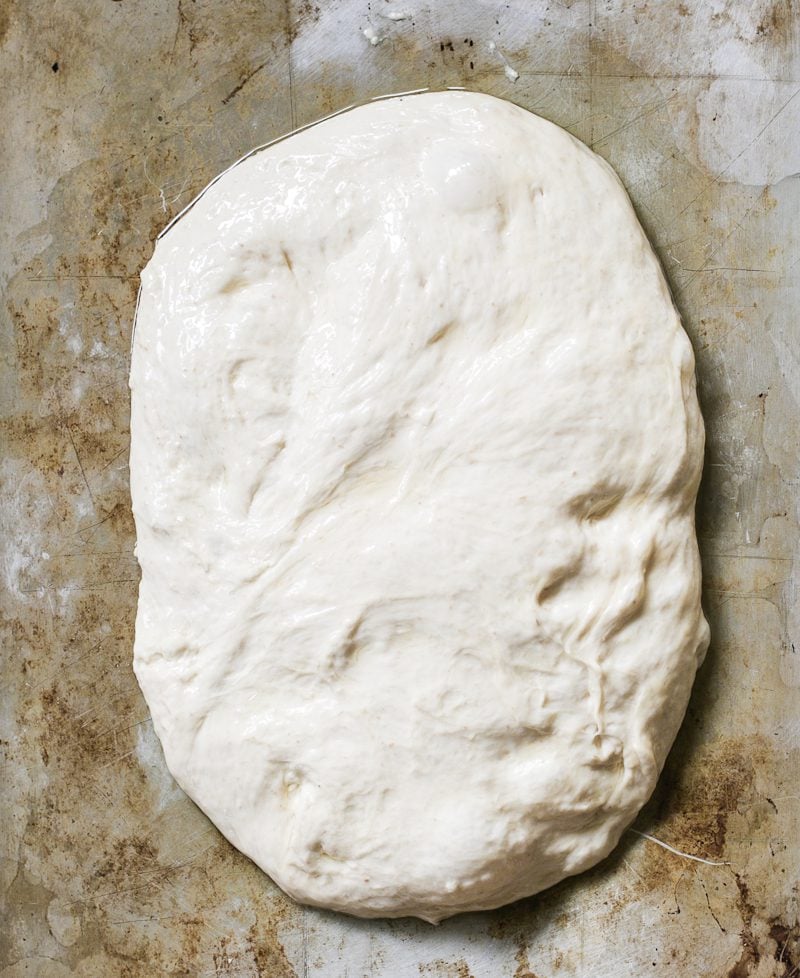
Second Rise
- In the morning: oil a rimmed sheet pan with oil (see tip below). Use your hands to evenly coat the bottom and sides. With oiled hands, gently remove the dough onto the pan. Flip it over to coat both sides. At this point, you do not need to pull or stretch the dough to fit the pan. The dough needs to relax first, which happens naturally in the next step.
- Cover the dough (I use an inverted sheet pan instead of wrap- it doesn’t touch the dough). Let rest at room temperature for 1 1/2 to 2 hours or until puffy. Preheat your oven to 425 F (220 C).
- Note: I like to rest my dough in a warm spot, usually on top of the oven while it preheats. The dough becomes more soft and bubbly.
Tip: Instead of a sheet pan, you can bake sourdough focaccia in a non-stick rectangular pan instead (9 x 13- inch or 10 x 14-inch).
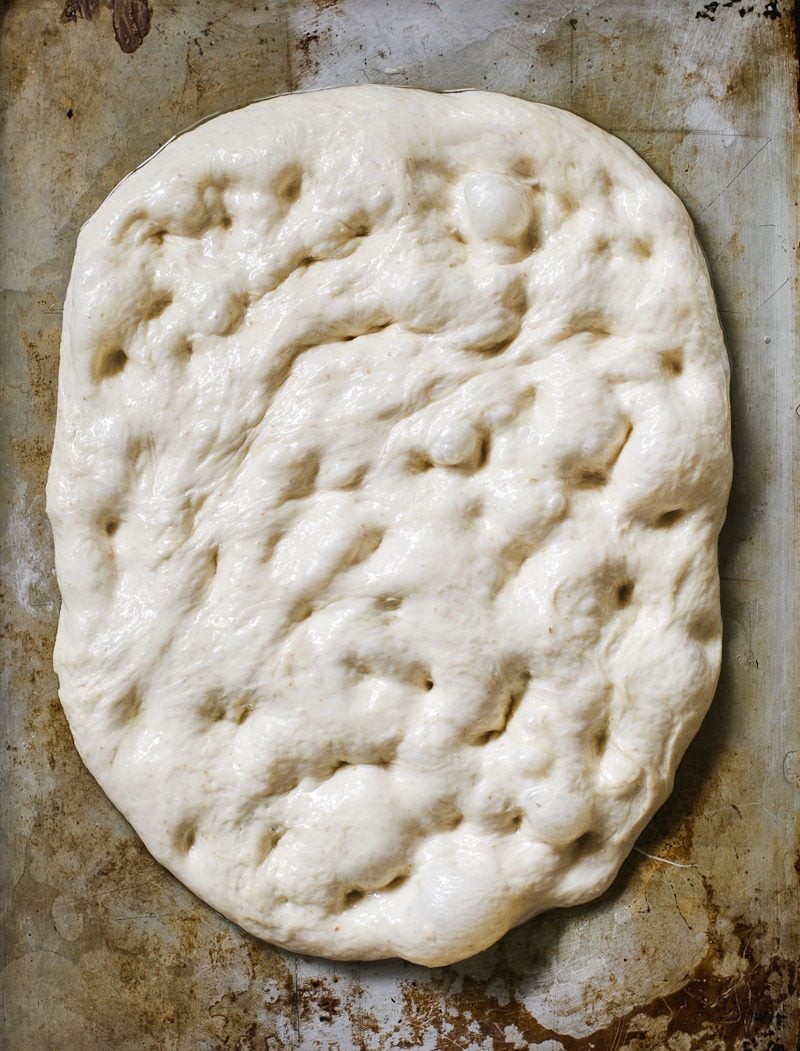
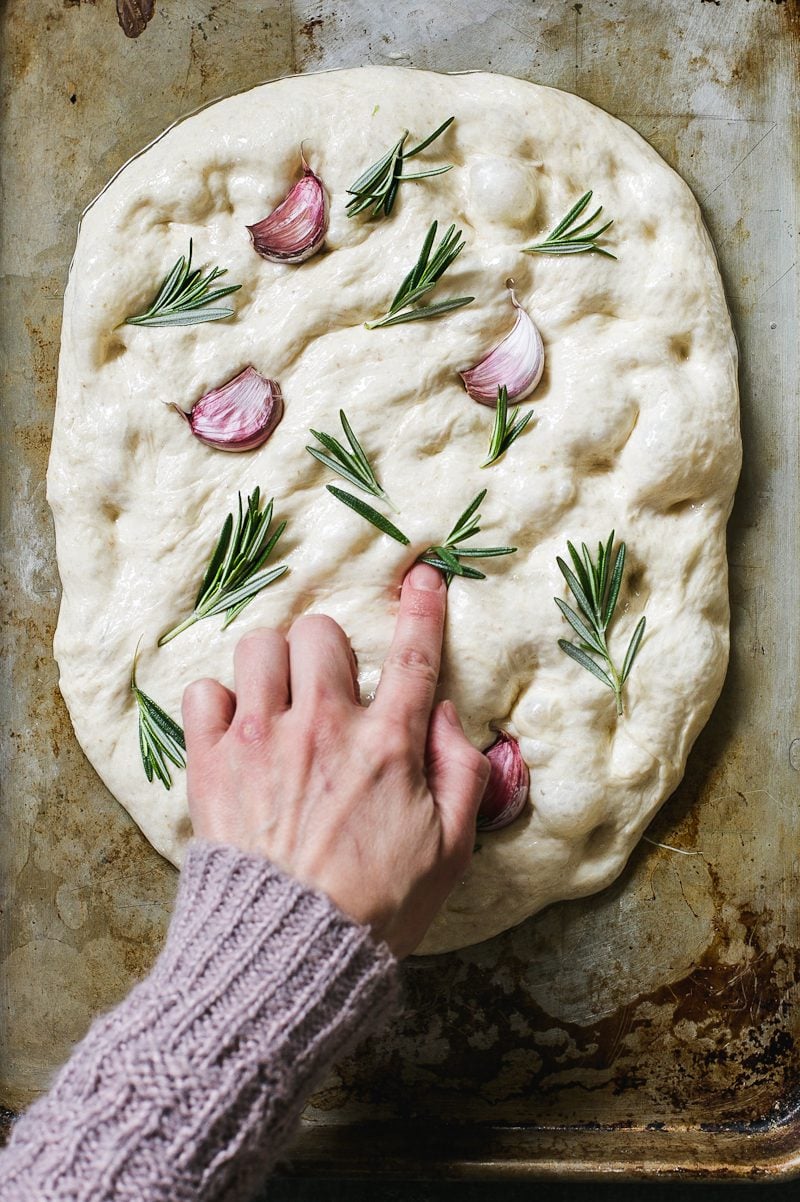
Assemble The Focaccia
- Right before baking, gently dimple the dough with oiled fingertips. As you dimple, the dough will naturally begin to stretch outwards. Continue to dimple and stretch (gently!) until you’ve created a rustic rectangular or oval shape, about 14 x 9-inches (36 x 23 cm) or larger. The dough won’t go all the way to the corners and sides of the sheet pan- this is OK.
- If using toppings, press them into the dough. As the dough rises it will puff up, so the toppings need to be well anchored- press down deeper than you’d think. Otherwise they will pop out!
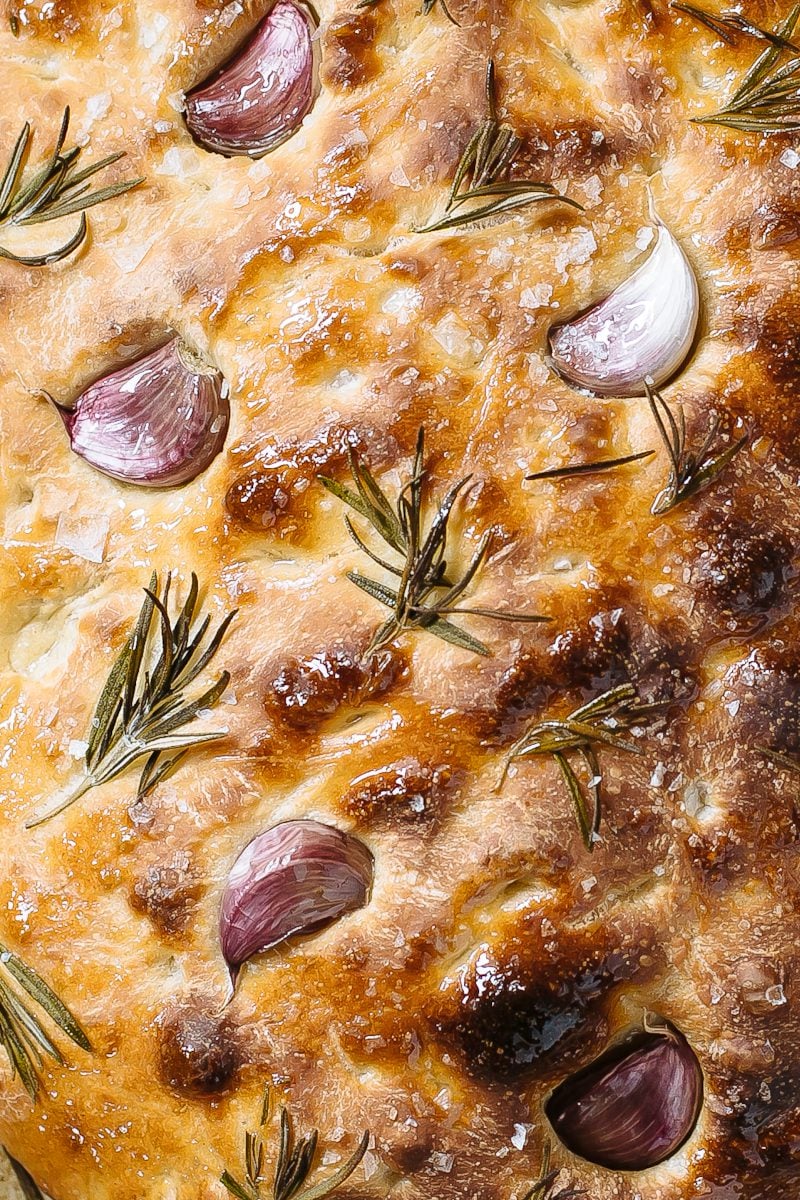
Bake The Focaccia
In the oven, set the dough on the center rack. Bake the focaccia for 25-30 minutes or until golden brown. Remove from the pan and cool on a wire rack (so the underside does not steam) for at least 30 minutes. Cut into wedges or squares, and serve warm with dipping oil, if preferred. Delicious!
TIP: How to Par-Bake Sourdough Focaccia: If you want to make focaccia in advance, and time fresh, baked bread for dinner, par-bake the dough. To do this, bake the focaccia for approximately 15-18 minutes @ 425 F (220 C). The crust will be set, very pale in color and golden underneath. Remove the focaccia from the pan and cool on a wire rack. Once completely cool, wrap in plastic wrap and store at room temperature for up to 6 hours. To finish, bake the focaccia in the pan for 12-15 minutes. PS: par-baking focaccia bread is really convenient when you want to bring that “wow factor” to a party!
Sample Baking Schedules
The key to sourdough is timing. Here are 2 sample baking schedules to follow and adapt according to season. In my experience, the overnight method is best in cooler temperatures (the dough can survive a long rise without becoming over proofed in the morning). The daytime method is best in warmer temperatures when the dough rises faster. As a rule of thumb, temperature controls time and ultimately: your baking schedule.
Fall/Winter (overnight method)
- 4-6:00 PM: Feed starter
- 8:00 PM: Make the dough
- 8:30 PM: Let rise overnight (bulk rise)
- 8:30 AM (the next day): Inspect the dough. Does it need more time to rise? If so, give it more time, otherwise continue on.
- 9:00-11 AM: Second Rise
- 11:30 AM: Par-bake or Bake.
Spring/Summer (daytime method)
- 8 AM: Feed starter
- 10 AM: Make the dough
- 10:30 AM: Let rise during the day (bulk rise)
- 3:00 PM (onwards): Second rise
- 5:00 PM: Par-bake or Bake
More Sourdough Bread Recipes to Try!
- Sourdough Bread: a Beginner’s Guide
- Best Sourdough Pizza Crust (No steel or stone!)
- Best Sourdough Pancakes
- Easy Homemade Sourdough Bagels
- Easy Sourdough Sandwich Bread
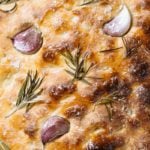
Beginner’s Guide to Sourdough Focaccia Bread
- Prep Time: 15 hours
- Cook Time: 30 minutes
- Total Time: 15 hours 30 minutes
- Yield: 1 large focaccia
- Category: Sourdough Bread Recipes
- Method: Oven-Baked
- Cuisine: American
- Diet: Vegetarian
Description
Learn how to make THE BEST easy sourdough focaccia bread recipe (step-by-step!), with bubbly, active sourdough starter, a simple overnight rising option, and tips for par-baking the dough. So soft! So fluffy! Focaccia recipe adapted from my book: Artisan Sourdough Made Simple.
Ingredients
- 50–75 g bubbly, active sourdough starter
- 375 g water (see Notes below)
- 20 g honey (optional)
- 500 g bread flour or all purpose flour (see Notes below)
- 9 g fine sea salt
- 2–3 tbsp olive oil, for coating the pan
- Assorted Toppings (optional): rosemary, garlic cloves, flaky seat salt, tomatoes, olives etc.
Notes:
- Thoughts on Flour: You can use bread flour or all purpose flour to make sourdough focaccia. Comparatively speaking, bread flour yields a slightly chewier focaccia with a higher rise. All purpose flour creates a more tender focaccia. The choice is up to you. If you prefer to use all purpose flour, I do recommend King Arthur brand. Coming in at over 11.7% protein, this flour is stronger than most all purpose flours, which means it can handle a higher quantity of water without the dough becoming a gloppy mess. It’s actually stronger than most bread flours! If you cannot access this flour, make the following changes to ensure success: decrease the water to 325-350 g (start small and work your way up) OR use King Arthur bread flour with 375 g water instead.
- Thoughts on Sourdough Starter (quantity): When the weather is cold, I’ll use a higher amount of starter to give the dough a boost when doing a long, overnight rise. I’ve given you a range so you can decide what suits you best.
- For Baking: You will need a rimmed sheet pan or non-stick rectangular pan (9×13-inch or 10×14-inch)
Instructions
Before you begin: decide when you want to make the dough. The instructions (below) outline a long, overnight rise @ 68-70 F (20-21 C) Alternatively, you can rise the dough during the day. Please refer to the sample schedules in the post above and choose what suits your needs.
- Make the Dough: In the evening: whisk the sourdough starter, water and honey together in a large bowl (I use a fork for mixing). Add the flour and salt. Mix to combine and then finish by hand to form a rough dough. It will be wet and sticky. Cover and let rest for 30 minutes to an hour. Timing is flexible here. Then return to the bowl and work the dough into a ball.
- Bulk Rise: Cover the bowl of dough with lightly oiled plastic wrap (or transfer the dough to a lightly oiled dough container). Let the dough rise overnight at room temperature, approximately 68-70 F (20-21 C) for about 12+ hours. The dough will double in size (or more) when ready. Note: if the weather is warmer than 68- 70 F (20-21 C) the dough will rise faster than 12+ hrs. Please adjust your timeframes accordingly.
- Second Rise: In the morning, pour 2 tbsp. of olive oil onto a rimmed sheet pan (or 1 tbsp. olive oil if using a non-stick rectangular pan). Use your hands to evenly coat the bottom and sides. With your oiled hands, remove the dough onto the pan, and then flip it to coat both sides. Cover and let rest for 1 1/2- 2 hours or until very puffy (I use an inverted sheet pan to cover the dough). Preheat your oven to 425 F (220 C). Note: I like to rest my dough in a warm spot, usually on top of the oven while it preheats. The dough becomes soft and bubbly.
- Assemble the Focaccia: Right before baking, gently dimple the dough with oiled fingertips. I start at the bottom of the pan and work my way to the top. As you dimple, the dough will naturally begin to stretch outwards. You should end up with a rustic rectangular or oval shape, about 14 x 9-inches (36 x 23 cm) or larger. The dough won’t go all the way to the corners and sides of the sheet pan- this is OK. Note: If using a rectangular pan, the dough will naturally fill the shape of the pan.
- Add Focaccia Toppings (optional): Press your preferred toppings into the dough. As the focaccia rises, the dough will puff up. The toppings will pop out if not properly anchored. If using garlic, I keep the cloves wrapped in their papery peels to prevent burning. Remove and discard the peels before eating.
- Bake the Focaccia: Place the dough onto the center rack. Bake for 25-30 minutes or until crisp and golden brown. Remove from the oven and cool on a wire rack before cutting. TIP: To par-bake focaccia dough: Bake for approximately 15-18 minutes @ 425 F (220 C). The crust will be set, very pale in color and golden underneath. Remove the focaccia from the pan and cool on a wire rack. Once completely cool, wrap in plastic wrap and store at room temperature for up to 6 hrs. To finish, return to the pan and bake for 12-15 minutes.
- To serve, cut the focaccia into wedges or squares and enjoy warm!
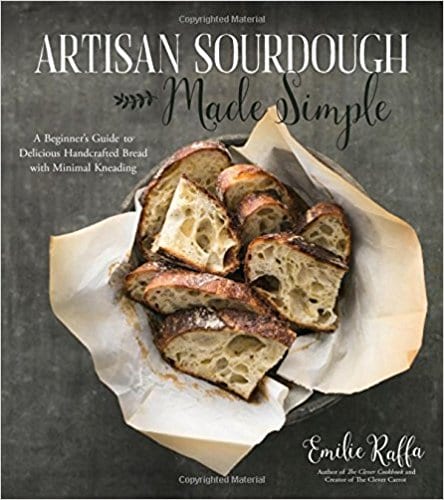


Comments
Annaliese says
Hi! If I parbake but want to finish it then next day should I store on the counter or in the fridge? Thank you!
Dawn says
This is my go to recipe and the results always impress! I have a tiny kitchen with no oven so I use a toaster oven to bake this and it works perfect. I have made this enough times that the recipe is committed to memory. Thank you for this.
Sophie Shores says
Does par-baking affect the bread’s texture?
Pat Merrell says
I found this on my NYtimes recipe feed last week the day my 22 years old granddaughter asked for starter and “the kit” for her birthday today.. your recipe was perfect for me do as I revived my started to share.. I made it in a large deep stainless straight sided frying pan, did great.. thank you . love your web page.
Zach says
Going to make tomorrow. My question is feeding starter. I see in your opening comments about feeding starter a few days ahead of time. So I fed mind today and let is grow in size for several hours. I put in fridge to be able to use tomorrow. Should I be sealing the jar off when doing that? Is that was you mean when you say feed a few days ahead of time?! New to sourdough here.
Sarah says
so chewy and delicious, thank you for the recipe!
SP says
I have a question about the garlic you put on top–why didn’t you peel it? When you are eating it, do you eat the outside, or do you take all the cloves out of the bread and peel them then?
Emilie Raffa says
The skin is left on to prevent the garlic clove from burning. You can simply peel off the skin before serving.
Jayesh says
I used to make sourdough focaccia from the King Arthur recipe and it was coming out good. I tried last weekend your recipe and it came out really great more airy light and tasty. Now onwards I am going to use your recipes.
Emilie Raffa says
Fantastic! Thanks for the feedback :) Enjoy the recipes!
Maddy says
Do you typically wait for your starter to triple before you start? Or do you use it after 2 hours regardless? My starter usually takes 4-6 hours to be “ready” for baking but not sure if the longer rise accounts for the starter not having risen as much (or my starter might just not be as active as yours)
Emilie Raffa says
Great question. I wait for my starter to at least double before using. This can take anywhere from 2-6 hours depending on temperature (the warmer it is, the quicker the starter will rise). I always go by what it looks like, not the clock.
Helen says
Like, are you kidding me with this bread??? Does it have some magical chemical process that creates crack in the dough so that you eat one piece and literally cannot stop? I don’t think I have EVER left a comment on a recipe in my life but absolutely had to do it here. This is one of my favorite sourdough things I have made to date and by far one of the easiest. I sprinkled my top with salt and pepper, garlic powder, and Italian herb seasoning and then we all died and went to heaven. I’m writing this from beyond the grave, where I am still eating the focaccia. Thank you for this recipe!
Tonja H says
I’ve used this recipe so many times I’ve lost count. I have even had friends ask me to make it for them – it’s so good. I just made more this evening and used garlic cloves, garlic stuffed olives, black olives, red onion and fresh rosemary. I had even mixed rosé infused pink Himalayan salt into the dough. It’s so delicious! I will be making this focaccia bread for years and years to come. Thank you so much for sharing it
Tamlin says
I just made this from your cookbook. It’s amazing! I used herbs de Provence and garlic, and we can’t stop eating it! Thank you!
Jen says
I’ve made this 3 times now and I’m super happy with how it’s turned out each time!
I was wondering how it would work if I make the dough over night like I normally do but then refrigerate during the day while I’m at work to then take it out when I get home let it come to room temp and bake 2-3 hours later for dinner.
Karen says
That would be fine.
Stacey says
Made this recipe on Thursday -> Friday and it was delicious! I made a mistake w the water (converting from metric to standard) and had to improvise w adding flour, but once I saw the r bubbles and it rising I became more hopeful! We added niches garlic, Italian herbs and Parmesan cheese…so delicious! Even better the next morning toasted! Will def make again!
Elizabeth R Simpson says
Delish. I wish I could add a picture. I did something a little different and added my rosemary into the dough after the bulk rise, next time I may add some toasted garlic to the bulk dough. This one had roasted red pepper, pesto, sun dried tomatoes and goat cheese on it.
Suzanne DeGraffenried says
Thank you! New to sourdough and baking in general, but I really liked how it turned out!
Savanna Crossman says
What level of fermentation are we looking for with this recipe? The fermentation window of 12-24hrs threw me off a bit.
Am I looking for the same level of fermention that I would with a loaf of bread?
Lindsay says
I just made this recipe with my brand new starter. It was my first sourdough bread! It was so easy. I followed the version from the cookbook (so I didn’t do the 30min rest or decrease the water — only differences I notice between the recipes).
It really stuck to the pan which surprised me. So I’m wondering what I did wrong. I thought since extra virgin olive oil has a low smoke point I would use avocado oil. (I don’t have plain olive oil) was that the problem? I also used a Pyrex 9×13 pan sitting on a jelly roll pan.
I’d like to improve for next time so what do you think I could do to make it better?
Thanks!
I can’t wait to try more of the recipes from your book and on this blog. Your bagel recipe is next on my list!!
Emilie Raffa says
Hi Lindsay! Great question. It was the glass pan. They are notorious for sticking unless you butter AND oil them first (and even then it’s not a 100% guarantee). I don’t bake bread in glass pans (only metal). However, if you want to continue using what you have, consider lining the bottom and sides with parchment paper first. The bottom crust might be a little less crispy, but still good. Hope this helps!
Lindaay says
Thanks! I’m glad it’s an easy solution. I will try with a metal pan next time.
Thelma says
Can u not put the recipe in cups etc instead of g. Have no idea how much that is. I’m in
USA
Ida says
Metric system is far more accurate than using cups. I would recommend getting a kitchen scale!
Otherwise you can convert grams to cups using an online converter.
Angeli Sivaraman says
This recipe rocks!! I put garlic, Kalamata olives, and rosemary in mine. It turned out really good! Thank you so much!
Emilie Raffa says
Sounds incredible! Yum!
Kristine S says
The first sourdough bread I made and I now make it every week. It’s perfect! People always ask me to make it for any gathering I’m going to. Thanks Emilie!
Lorrr says
I am in the last ride when I turned it out into The pan it was runny should I put more flour
Angeli Sivaraman says
Oops – sorry! Just read the part that says no kneading!!
Angeli Sivaraman says
So… do you not knead in this recipe? Thanks!
Denise says
Great recipe – I’m new to bread making and once I found the right pan ( 9×13 nonstick) this has turned out perfectly. Even when it stuck to the pan it was so delicious that we didn’t care that it was missing the bottom! I have topped it with rosemary and Gruyère cheese. So good!
Kimberly says
Can you put the toppings on then par bake?
Michelle says
That’s what I just did. It worked great and tastes sooo good!
Gloria says
I made this focaccia today and it is amazing. It was my 1st recipe using a sourdough starter. I added cherry tomatoes, kalmata olives and whole garlic cloves to the top of my bread before baking. It’s so rewarding to have such an awesome outcome with this delicious recipe!
Thank you!
😍
Kris Bean says
Can’t wait to make this. Can I line the rectangular pan with parchment paper to prevent sticking? I put parchment into my dutch oven when baking my sourdough loaves. I am guessing that if I use parchment paper I should not put oil on it.
Tara says
Foccacia is essentially bread made with lots of oil and herbs, without the oil you’re just making a normal sourdough loaf. – personally I use garlic infused olive oil so get more flavour
Michelle says
I lined my pan with parchment. Worked great!
Will says
Do veggies that you put on top need to be roasted prior or do they cook enough in the 20-30 minutes while the bread bakes?
Chrystal Carreras says
New-bee here.
I followed every instruction to a T. Weighed all the ingredients and followed the video. My dough came out way too dry, so I added water. It’s still in the rising process but looks nothing like the picture of the dough in the bowl (I used bread flour) I saw a comment for if the dough is too soggy but not too dry.
Do I through it out and start over? I’m open to all feedback :)
Emilie Raffa says
Hi Chrystal! Welcome to the group ;) What brand of bread flour are you using? And when you say dry, do you mean there’s actual dry bits of flour in the dough? Or it’s just stiff looking? Thank you!
Laura says
I love this recipe–the only challenging part is timing (always a challenge with sourdough). I tend to use 2/3 whole wheat bread flour and 1/3 white bread flour and add more starter (~95 g) and more water (starting with 375 g and adding more as needed) since the whole wheat flour absorbs more water. It comes out bubbly and fluffy as we like it here. I have made it with a wide range of toppings, and all were fantastic. The family favourite is gruyer or any other swiss cheese and rosemary (both added before baking).
summer says
hi! newbie here- I attempted to make my first sourdough but it completely failed. i hope this focaccia works, since it is my favourite bread. i love the taste of whole wheat, and since i’m a beginner, do you have any full measurements? thank you :)
Amy Anderson says
This was so easy and incredibly delicious. I did it in one day. Ate really late though. Warm weather but we keep the house cool so I did bulk rise and part of second rise in oven with the light on. Thanks!
Jacqueline Stone says
I wish I could post pictures of all of the times I’ve made this fantastic focaccia. I usually use 79 grams of starter and I also usually have to put it in the fridge because it bubbles away. My starter loves this recipe! Sometimes I’ll roast a head of garlic ahead of time (like right after making the dough) just to be able to put caramelized garlic on. Highly recommend it with spicy Calabrian chili flakes infused in good EVOO. Thank you for this!
Lauren says
I can’t stop making this recipe! I accidentally let it over proof on the counter once and left it proofing in the fridge for over 48 hours another time. Regardless it turns out delicious! I usually halve the recipe and bake it in a non stick 8×8 because the one time I did the whole recipe on a cookie sheet, it stuck really badly.
Angela W Broyles says
This worked out great for me! I LOVED the par-bake method!! I finished baking right before we went to friends for dinner- it was a total hit!!
Sid says
Hi Emilie! I’ve had my sourdough starter and have been baking sourdough bread since 2015! Stumbled across your website and decided to try something other than plain old bread. The focaccia recipe is outstanding! Crunchy on the bottom yet chewy on the inside. Have you ever tried freezing the focaccia after partial baking? That would be a great way to always have some focaccia at the ready for a quick meal. I par baked two this morning and decided to put one in the freezer for later this week. Hope it all works out! Thanks for the recipes! Will try the pizza dough recipe next.
Jill says
Hi!! Can I ask if that method worked?! Was thinking of trying the same!
Nicole says
Your sourdough focaccia recipe was OUTSTANDING! I used Bob’s Red Mill All Purpose, as that’s what I had on hand, and adjusted for 350g water and 50g sourdough starter. It turned out incredibly delicious: the crumb was perfect and the crust chewy and crunchy. Because it is so hot outside (July in Southern California) I baked mine on our gas grill using a cast iron skillet. Thank you for a new sourdough classic that will be replacing my boring old boule!
Rebecca says
Help!!
I’m
New to the sourdough world & am really enjoying the recipes in your cookbook – the English muffins & multigrain bread are big hits I’ve tried the no knead focaccia twice & each time the second rise doesn’t seem to “take”. It’s VERY runny – almost as if it hasn’t risen (this is after 2 hours). Ant thoughts I what the issue could be?
Thanks!!
Ivy says
This has been my problem as well!
Patty says
Mine seems runny or very soft…I just put my fingers in and made the holes, put topping on and baked. Turned out awesome. Good luck!
Heidi Freeman says
This recipe is fantastic! My starter was a little sluggish so I added a pinch of yeast and let it rise a little longer on the second rise – just watched it until it was the right level. I topped it with caramelized onions, tomato, and rosemary and brought it to a party where it disappeared!
Cheryl says
Hi
Can you add cheese and jalapeños to the dough before you bake it
Kevin O. says
I found this site about 3 months ago when I first started to learn to make sourdough.
Last night and this morning I attempted sourdough focaccia for the first time.
I used this recipe and it turned out absolutely amazing!
Thank you, Emilie for taking time to explore and explain how to accomplish this.
Your tips were spot on and your instructions were clear.
Thank you.